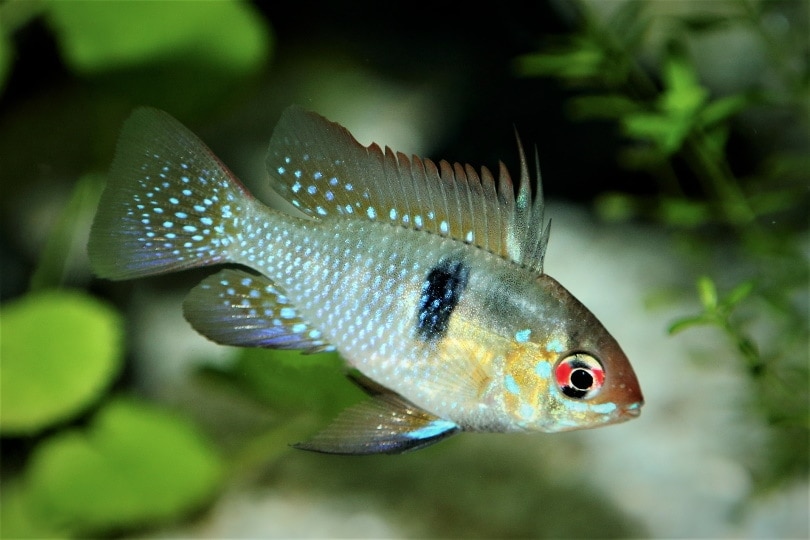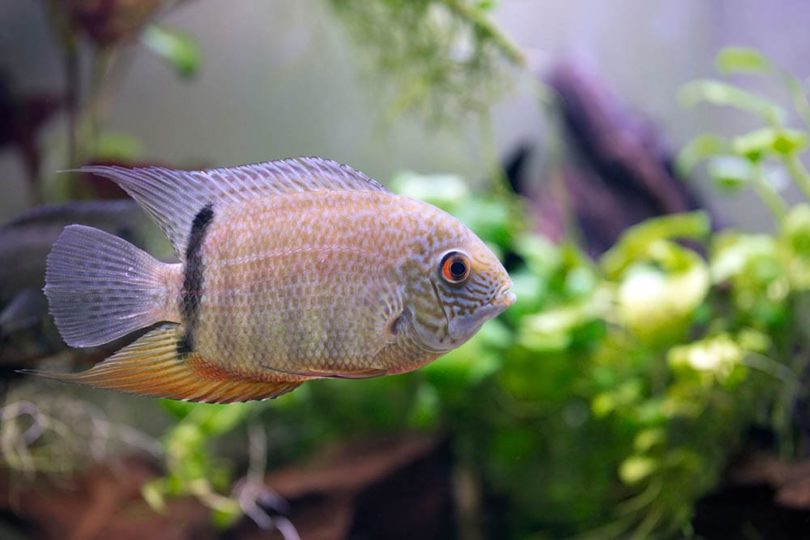20 Types of Cichlids for Your Aquarium (With Pictures)

Updated on

Cichlids are fascinating fish with lots of personality and their own unique charm. They are concentrated in specific parts of the world, like Lake Malawi in Africa. Just in Lake Malawi there are around 850 species of cichlid! There are around 1,300 species of cichlid that have been identified and named, but estimates put the actual number of cichlid species somewhere between 2,000-5,000. The vast majority of these are not kept in aquariums, but when it comes to choosing cichlids for your aquarium, it doesn’t mean you’re limited on options!

The 20 Types of Cichlids for Your Aquarium
1. Bumblebee/Hornet Cichlid
These cichlids are named for their yellow and black bumblebee-like markings. As they age, they take on more black color and lose some yellow, but they keep some of the yellow their entire life. They reach up to 4 inches in length and are rock-dwellers.
2. Electric Yellow Cichlid

Also known as Yellow Labs, these cichlids are some of the less aggressive cichlids for aquariums. The exception to this is when they are kept with fish that are similar to them in appearance, which leads to aggression. These fish are bright yellow in color with horizontal black stripes on their dorsal fin and black bars and stripes that can appear on the fins or body.
3. Red Zebra Cichlid
Actually more orange in color, red zebra cichlids are beautiful. Their stripes are a darker version of their main body color, so most of them are orange to red with darker orange or red stripes. In the wild, these fish take on more of a brilliant red coloration than is usually seen in aquariums. They are considered a vulnerable species in their native environment.
4. African Butterfly Cichlid
These cichlids are one of the smaller varieties, only reaching around 2-3 inches in length. They prefer slightly more acidic water than most cichlids do and they are peaceful when kept in community tanks with peaceful tankmates. Once spawning has occurred, these cichlids deposit their eggs into a pit and both parents will dutifully guard the eggs, becoming very territorial during this time. The colors on these fish are variable, but they are typically shades of blue, brown, and green with shimmery, metallic scales.
5. Peacock Cichlid

There are at least 22 species of Peacock Cichlids, but all of them are brilliantly colored. These fish are prized for their beautiful colorations with unique patterns. They are also sometimes called Fairy Cichlids. Like other Lake Malawi cichlids, they are rock-dwellers. They can reach up to 6 inches in length and are semi-aggressive, although they can live in some community tanks.
6. Butties

Butties are attractive black and white or silver fish that are often sought after as pets. However, they can reach 12-16 inches in length, so these fish are not for most fish keepers. They require a large aquarium with high filtration. Another issue that people run into with these fish is that the males can be very aggressive. Unlike most cichlids, which are mainly herbivorous, Butties will eat plants as well as fish, invertebrates, and insects.
7. Jaguar Cichlid

These fish are extremely unique and are named for their black spots. They have mostly white or silver bodies. They are large cichlids, reaching around 14-16 inches in length, so they require a very large tank. Jaguar Cichlids are exceptionally aggressive and territorial. They will kill other fish that they feel are encroaching into their territory. They are not a good fit for community tanks.
8. Angelfish

These fish are distinguishable by their triangular bodies and long, flowing fins. Many angelfish have clearly defined dark stripes and can be a variety of colors. Angelfish are some of the most popular aquarium fish and are extremely peaceful, making them an excellent choice for many types of community tanks.
9. Agassiz’s Dwarf Cichlid

These petite cichlids can be a variety of attractive colors, including red, blue, and gold. They reach up to 3 inches in length. They are rock-dwellers and are territorial, so plenty of caves need to be present in their environment. Agassiz’s Dwarf Cichlids are happiest when kept in harems, so only one male should be present in a tank with multiple females. Multiple males sharing a tank will likely end up with them killing each other until only one male remains.
10. Discus

Another clearly distinguishable cichlid variety, Discus have narrow bodies that look circular when viewed in profile. They prefer acidic water, with many of them preferring blackwater tanks. Discus come in a variety of beautiful markings, including spots, stripes, and patterns similar to leopard spots. They are relatively peaceful and can be kept in community tanks with other peaceful fish, but they can become aggressive toward each other and will defend their perceived territory.
11. Bolivian Ram

Also sometimes called the Bolivian Butterfly, Bolivian Rams are brightly-colored, peaceful cichlids. They can be kept in community tanks and only reach up to 3.5 inches in length. They can be found in solid-colored forms with markings like spots and stripes, as well as in highly-varied color forms with spots and stripes. They usually have red or orange trim along the edges of their dorsal and caudal fins.
12. German Blue Ram

Also sometimes called Electric Blue Rams, these fish are brightly colored and look almost like a mixture between Butterfly Cichlids and Bolivian Rams, with shimmery blue scales and high color variation. They can be kept in small community tanks and only reach around 2-3 inches in length.
13. Rainbow Cichlid
Popular in the aquatics trade for a long time, Rainbow Cichlids are beautiful and unique. They are peaceful and usually stay small, reaching around 3 inches in captivity, although they can sometimes grow to around 6 inches in length. They usually have a brightly-colored orange or gold body with a horizontal black stripe down the body. They can have accents of other colors just about anywhere on their body. These fish are well-known for their ability to change their colors based on their mood and whether it’s breeding season or not.
14. Keyhole Cichlid
These fish are named for their black spot near the back, upper portion of their body. They usually have tan, brown, or yellowish bodies and are somewhat rounded when viewed in profile, although not as noticeably round as Discus. Keyhole Cichlids are known for pressing themselves against rocks and debris underwater, like driftwood, when frightened, helping them to blend in. They are peaceful and can be kept in community tanks. Interestingly, these cichlids are the only species in their genus, which is Cleithracara.
15. Severums

Also called the Banded Cichlid, these fish are rounded but with somewhat thick bodies. They have distinct rows of white dots covering most of their bodies. They can reach almost 8 inches in length and are not commonly found in the aquatics trade. Their personalities come in a range from peaceful to aggressive.
16. Oscars

Oscars are popular in the aquatics world and are quite handsome fish, usually sporting black bodies with orange dots and patterns across their bodies. They require large tanks and can reach up to 14 inches in length. It’s important to note that Oscars are aggressive and are best kept alone.
17. Convict Cichlid

Named for their prison uniform look, Convict Cichlids have very distinct black and silver vertical stripes. They can reach up to 6 inches in length and are known for their aggression. They will eat other fish and invertebrates and often do best when kept in a tank alone or as a harem. They can sometimes be kept in tanks with other fish, but this is a risk.
18. Jack Dempseys

Colorful and attractive fish, Jack Dempseys have shimmering silver-blue scales across their darker colored bodies. They are notorious for being messy and extremely hard on plants, often happily uprooting and tearing up any plants in the tank. They prefer acidic water and are known as aggressive fish, making them a poor pick for most community tanks. They can reach up to 15 inches in length, making them unsuitable for many fish keepers.
19. Green Terror Cichlid

Closely related to the peaceful Bolivian Ram and similar in appearance, these fish are named for their high level of aggression. They are very lovely fish in appearance, but their personalities do make them difficult for community tanks. They usually reach around 8 inches in captivity, but if provided a large enough tank, they can get up to 12 inches in length.
20. Blood Parrot Cichlid

Blood Parrot Cichlids are similar in shape to the Keyhole Cichlid but have noticeably pointed faces. This gives them a beak-like appearance, which is where the “parrot” part of their name comes from. They are usually blood-red to orange and are a human-bred hybrid believed to be from Redhead Cichlids and Midas Cichlids. These fish are not the same thing as saltwater Parrotfish, although they have slightly similar appearances. They usually reach 7-8 inches in length, although 10 inches is not completely abnormal. The odd shape of their mouths and unusual body shape, coupled with the fact that they do not exist in nature, makes these fish somewhat debated since their deformities bring about some questions about the ethics of breeding them.
Conclusion
The list of cichlids could go on for days! They are all so distinct and special, and all of them have the capability of bringing some “oomph” to your tank. However, it’s extremely important to know exactly what type of cichlid you’re bringing home. This will help avoid the death of existing fish in the tank, inappropriate water parameters, and having a tank that is far too small for a fish that will get very large. Many varieties of cichlids are available through pet stores, fish stores, and breeders, so you have lots of great ways to find a specific type of cichlid that will suit your tank.
See Also:
Featured Image Credit: david6239, Pixabay









